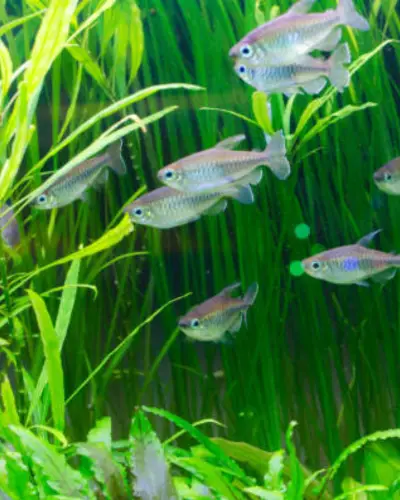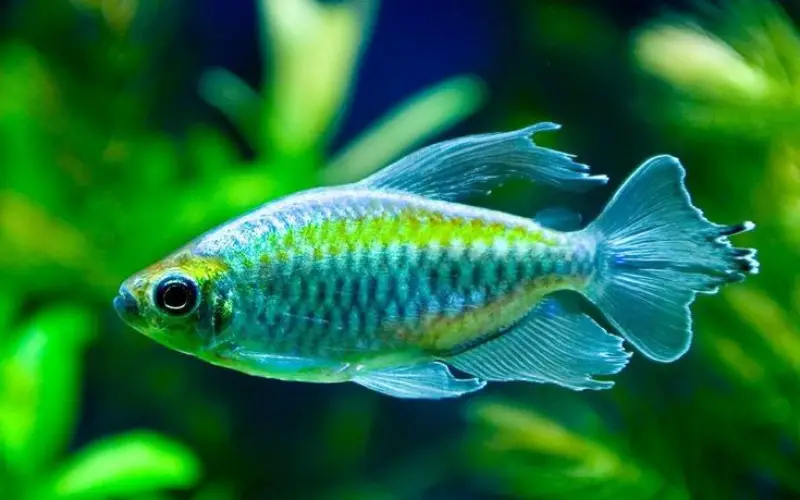The Congo Tetra’s vibrant orange and black stripes are a captivating centerpiece for any freshwater aquarium. However, choosing suitable Congo tetra tank mates can be tricky.
You want companions that thrive in the same environment, complement your personality, and keep things interesting in your underwater world.This is where our comprehensive guide comes in!
We’ve compiled the TOP 7 Best Congo Tetras Tank Mates, featuring species that share similar needs and create a harmonious community.

From peaceful algae eaters to playful schooling fish, discover the perfect companions to enhance your Tetra’s life and create a thriving, beautiful aquarium.
Dive in and learn about the best options for your Congo Tetras tank mates, and watch your aquarium flourish with happy, healthy fish!
Table of Contents
ToggleCongo Tetra Habitat and Care
Congo Tetras are colorful and vibrant African aquarium fish found in the Congo River Basin. Due to their peaceful nature and stunning appearance, they are popular for planted tanks.
In the wild, Congo tetras are shoaling fish that thrive in slow-moving waters with plenty of plants for cover. To care for Congo Tetras, it is important to provide a tank full of plants or spawning mops and a substrate that mimics their natural habitat.

The males’ vibrant coloring will display best in a slightly acidic pH level, around 6.0-6.5. When breeding, the female will lay eggs among the plants, which will hatch within a few days. Separating the adults from the fry is recommended to prevent them from being eaten.
Regarding tankmates, Congo Tetras do well with other peaceful fish such as tiger barbs, cories, and loaches. Larger fish like cichlids or aggressive species may cause them to become stressed.
A filter with a gentle flow is ideal for their habitat, as they prefer dimly lit environments with plenty of shade. Consider adding Java moss or other plants for extra cover. Congo Tetras will feel most at home in a biotope aquarium with a setup that mimics their natural habitats in the Congo River Basin.
TOP 7 Best Congo Tetra Tank Mates Species
When selecting good tank mates for Congo tetras, choosing species compatible in temperament, size, and water parameter requirements is essential.
Here are seven excellent choices for Congo Tetras tank mates:
1. Corydoras Catfish:
Peaceful bottom feeders that clean up leftover food and add a playful presence to the tank.
2. Harlequin Rasboras:
Peaceful schooling fish that stay in the mid-water level, like Congo Tetras, come in various vibrant colors.
3. Neon Tetras:
Small, peaceful, classic schooling fish are perfect for adding shimmer to the mid-water level with the Tetra Congo.
4. Cardinal Tetras:
Like Neon Tetras, Cardinal Tetras are slightly larger and have a beautiful red body with a black stripe.
5. Dwarf Gouramis:
Peaceful gouramis that occupy the tank’s top level add variety and color. Choose dwarf varieties to ensure they don’t threaten the Congo fish.
6. Bristlenose Pleco:
Peaceful algae eaters clean the tank and stay in the lower levels, leaving the mid-water for the Congo Tetras.
7. Honey Gouramis:
Another peaceful gourami option stays in the top level of the tank, leaving the mid-water for the Congo Tetras. Honey Gouramis are known for their beautiful yellow color.
Remember to consider tank size and temperament when choosing tank mates. You can create a beautiful and harmonious community tank for your Congo Tetras with little research.
Congo Tetra Diet and Feeding
The Congo Tetra Phenacogrammus interruptus is an omnivore that eats plant and animal matter. In the wild, they typically feed on a variety of foods including:
- Small insects
- Worms
- Crustaceans
- Algae
- Plant matter
In captivity, Congo Tetras are not picky eaters and will readily accept a variety of foods. A good diet for them should include:
- High-quality flake food or pellets: This should be the staple of their diet.
- Frozen or live brine shrimp, daphnia, or bloodworms: These will provide them with essential protein and help to keep their colors vibrant.
- Spirulina flakes or algae wafers: These will provide them with vegetable matter.
Here are some additional feeding tips for Congo Tetras:
- Feed them a small amount of food several times daily rather than one large feeding.
- Vary their diet to ensure they are getting all the nutrients they need.
- Don’t worry if they are shy about eating at first. If you turn off the tank lights for a few minutes, they may be more comfortable feeding.
- Avoid overfeeding, as this can pollute the water.
By following these tips, you can help to ensure that your Congo fish stays healthy and active for many years.
Breeding Congo tetras in A Community Fish Tank
Breeding Congo tetras in a community tank can be a rewarding experience. These fish are known for their vibrant colors and energetic nature, making them popular among aquatic enthusiasts.
To successfully breed Congo tetras, it is vital to set up a separate breeding tank large enough to accommodate the parents and any potential fry. The male Congos often display their brightest colors and most elaborate fin displays to attract a mate.
In a breeding tank, you might be able to keep other community fish like ram cichlids or rainbow fish, but it is essential to ensure that the water quality remains high and that enough food is available for all the fish. Breeding synodontis are really lovely and can add a spectacular element to your main fish tank.
Creating a suitable environment for breeding Congo tetras may involve adding aquatic plants like Anubias, moss, or spawning mops to provide hiding places for the fry. Additionally, keeping the tank lit on the dim side can help the parents feel more secure and protective, which may lead to a higher breeding success rate.
Proper filtration and regular water changes are essential for maintaining the tank’s water quality, which will ultimately lead to happier and healthier fish. Additionally, feeding powdered infusoria to the fry can help ensure they receive enough food to grow and thrive.
Commonly Asked Questions about Fishkeeping Congo Tetra Aquarium & Tankmates (FAQs)
What fish can go with a Congo tetra?
Peaceful fish that occupy different tank levels are good Congo tetra tank mates. Consider Cory catfish, neon tetras, dwarf Gouramis, or bristlenose plecos.
Are Congo Tetras aggressive?
Congo Tetras are generally peaceful towards similar-sized fish. However, they can be fin nippers and may harass slow or small tankmates. Keep them with a school of their kind and avoid fin-nipping species.
How many Congo Tetras are together?
Congo Tetras are schooling fish and thrive in groups of 6 or more. This provides them with a sense of security and allows for natural social behaviors.
How many Congo Tetras are in a 75 gallon tank?
The ideal number of Congo Tetras for a 75 gallon tank is 20-25. They are schooling fish that thrive in groups for security and natural behavior. Avoid overcrowding to prevent stress.
How big do Congo Tetras get?
Male Congo Tetras Phenacogrammus interruptus reach up to 3 inches (7.5 cm) long, while females are slightly smaller at 2.75 inches (7 cm). These peaceful fish are known for their dazzling, iridescent colors.
Firemouth cichlid and Congo tetra as tank mates?
Firemouth cichlid and Congo tetras tank mates: Firemouth cichlids can be aggressive. Congo tetras might be fin nipped or even eaten. Opt for peaceful Central American cichlid tank mates or larger tetras like the Congo tetra itself.
Conclusion
Creating a thriving aquarium is an exciting journey, and choosing the good tank mates for Congo tetras is crucial. Remember, successful tank pairings go beyond just aesthetics. It’s about understanding the needs of each species and ensuring a harmonious environment where everyone can thrive.
This guide has explored some of the best choices for Congo Tetra tank mates, highlighting their compatibility, personality, and the benefits they bring to your underwater ecosystem. Ultimately, the perfect mix depends on your specific goals and your building environment.
Don’t be afraid to research and experiment! Every successful aquarium is a testament to careful planning and dedication. By understanding each species’ nuances and needs, you can create a beautiful and biodiverse ecosystem that brings joy and peace to your home. Happy fish keeping!
Recommended posts
- Congo Tetra Size Does Matter? Freshwater Fish Aquarium Tips!
- Keeping Congo Tetra Fish 101: (A Comprehensive Care Guide)
- Can You Mix Silver Tip Tetras with Other Fish (Tank Advice)
- Congo Tetra Male Vs Female: Identifying Gender & Best Ratio!
- Congo Tetras Lifespan 101: (Aging Signs and Symptoms)
- Cherry Red Congo Tetras 101: (What You Need to Know!)
- The Basics of Breeding Congo Tetra Fish: A Step-by-Step Guide
- Is Congo Tetras Aggressive: (Tips for Peaceful Aquarium)
- The Ideal Congo Tetra Water Temperature: (Complete Beginner Guide)
- Blue Eyed Golden Congo Tetra 101: An Overview of This Stunning Fish
- Mixing Angelfish and Congo Tetra in Your Aquarium Tank
- Stunning Albino Congo Tetra Fish: A Comprehensive Care Guide
- Yellow Tailed Congo Tetra: Alestopetersius Caudalis Fish Profile




